[Sample Submission Guide] Baitai Peike Proteomics and Metabolomics Sample Volume & Sample Collection and Transport Requirements
1. Sample Submission Requirements
1. Qualitative Proteomics1.1. Conventional Qualitative Proteomics
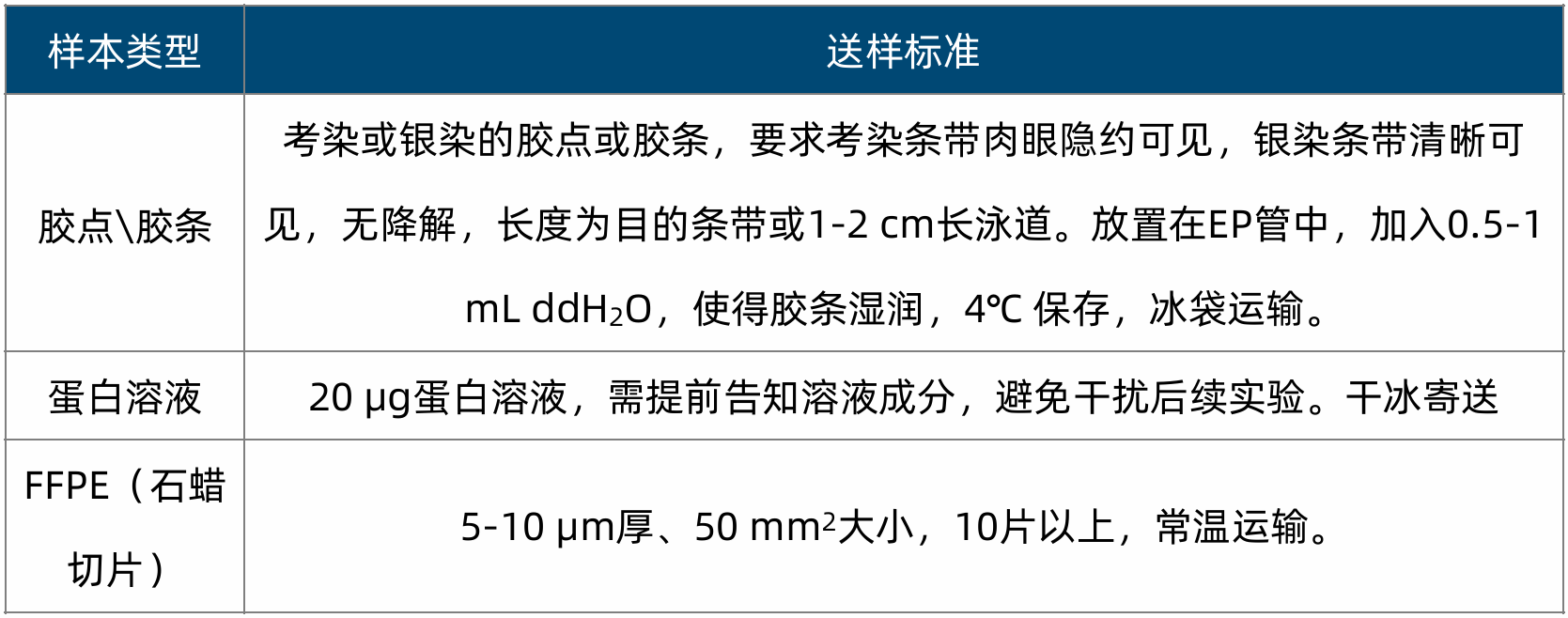
1.2. Interaction Qualitative Proteomics
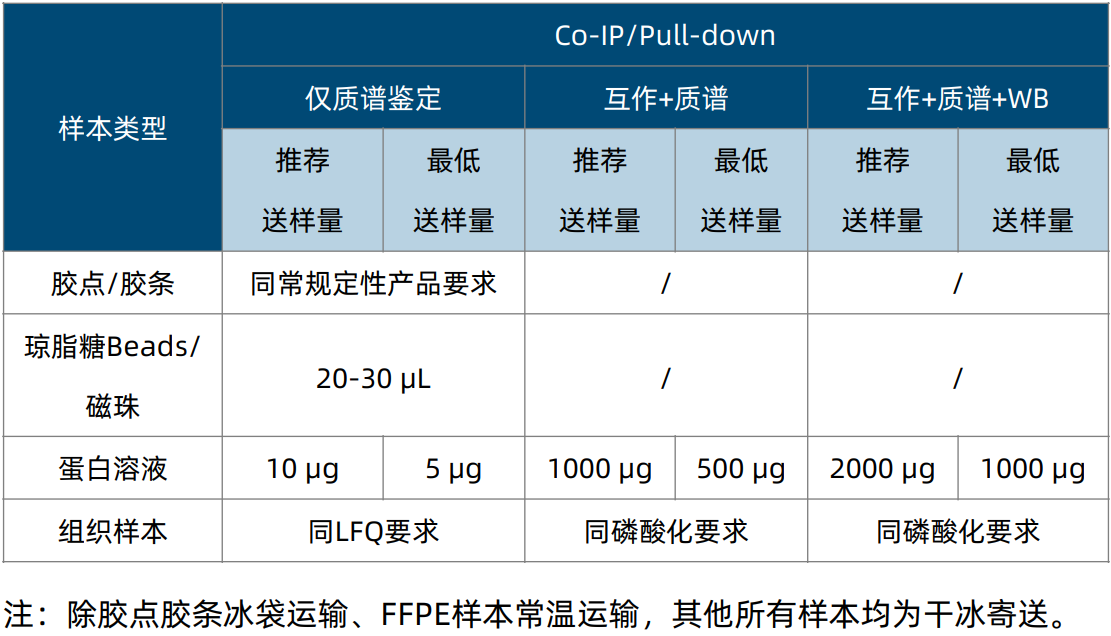
2. Quantitative Proteomics
2.1. Conventional Proteomics (Label Free/DIA/TMT)
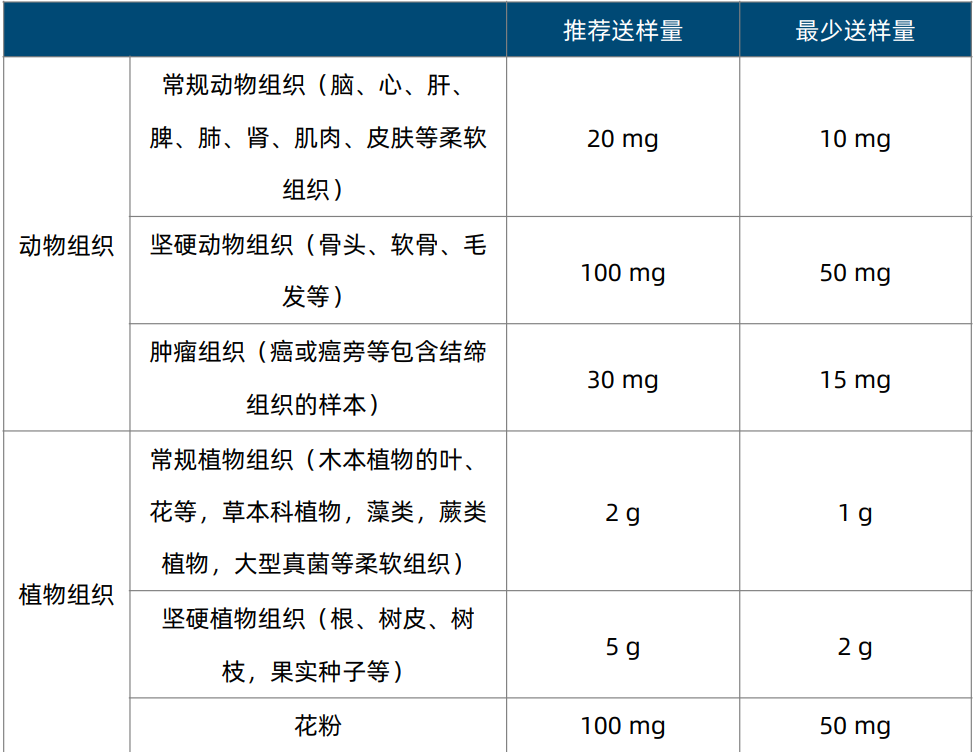
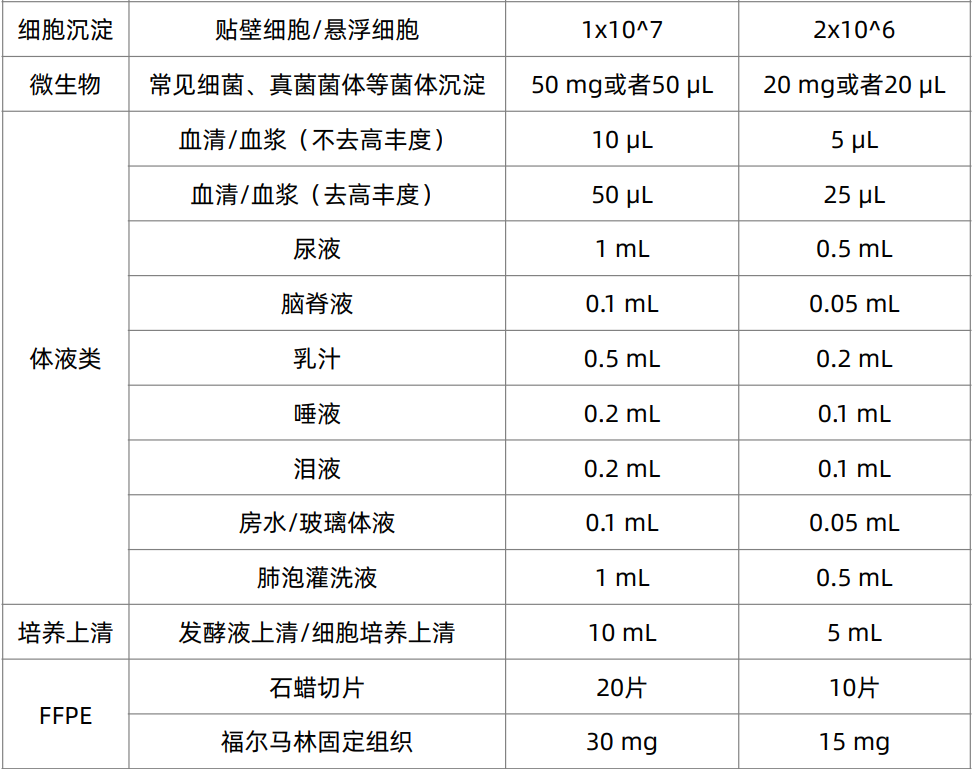

2.2. Modified Proteomics
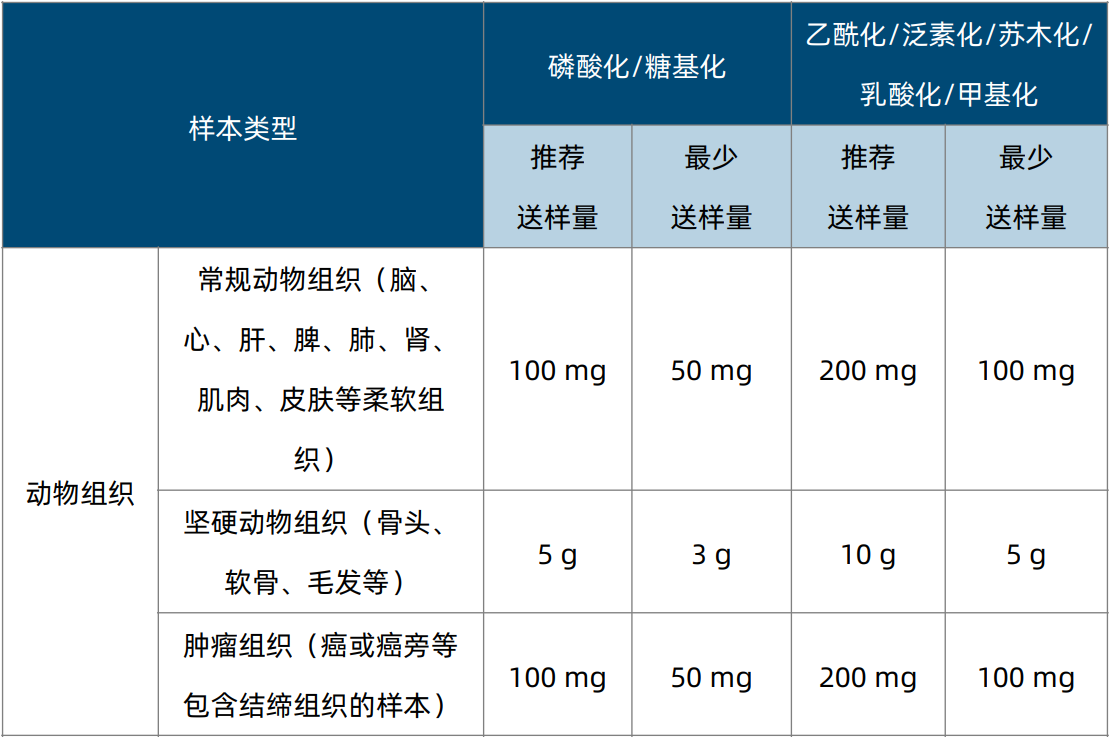
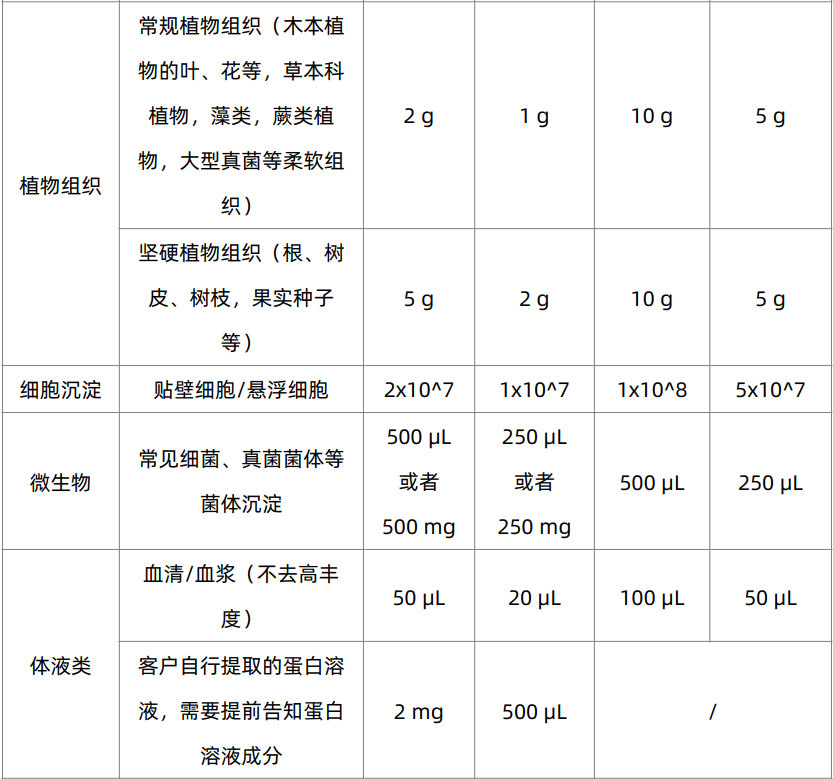

2.3. Microproteomics
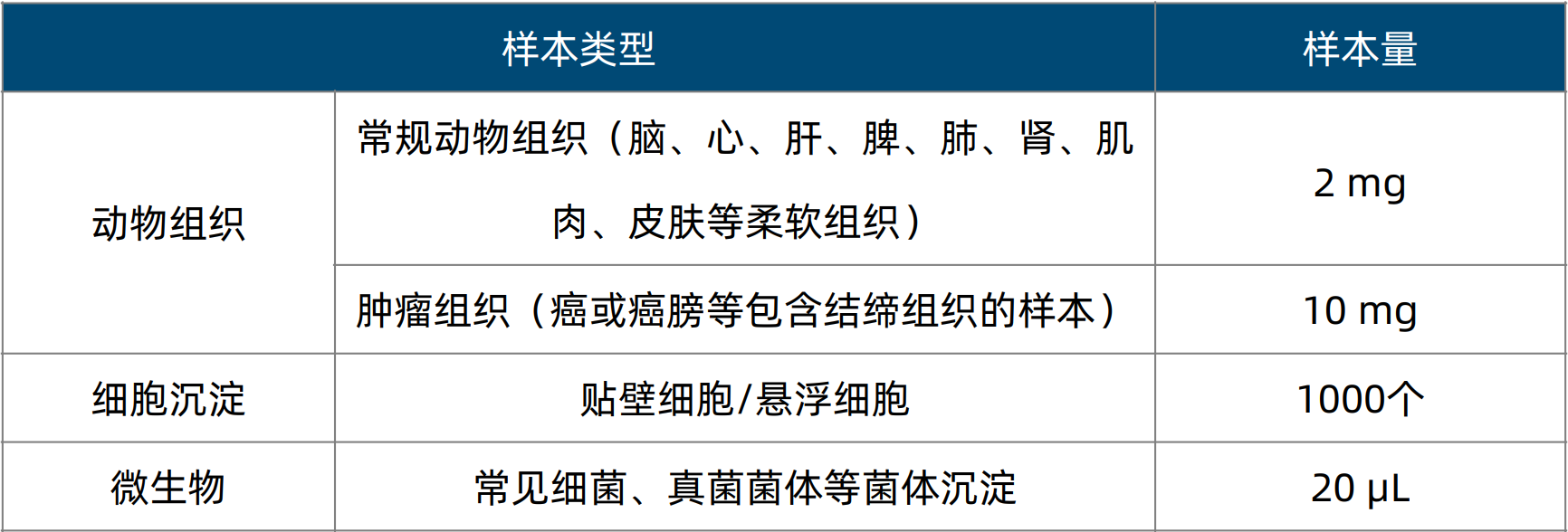


3. Special Proteomics
3.1. Chemical Proteomics (Drug Targeting)

3.2. Metaproteomics

3.3. Exosome Proteomics
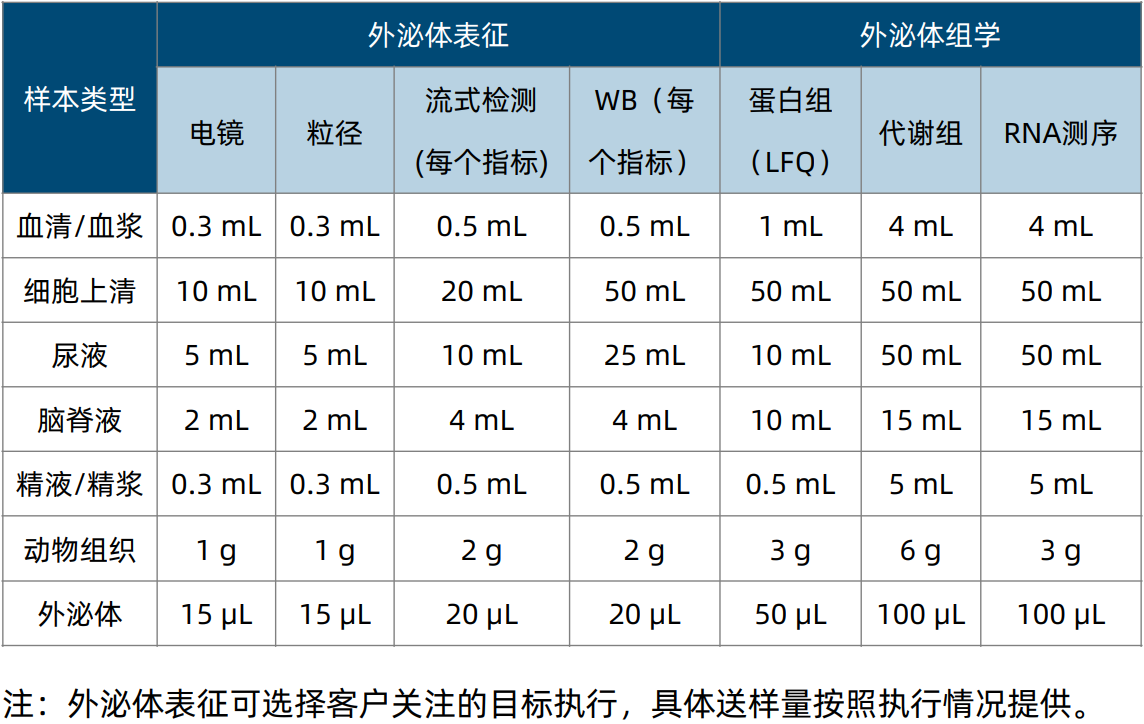
4. Peptidomics

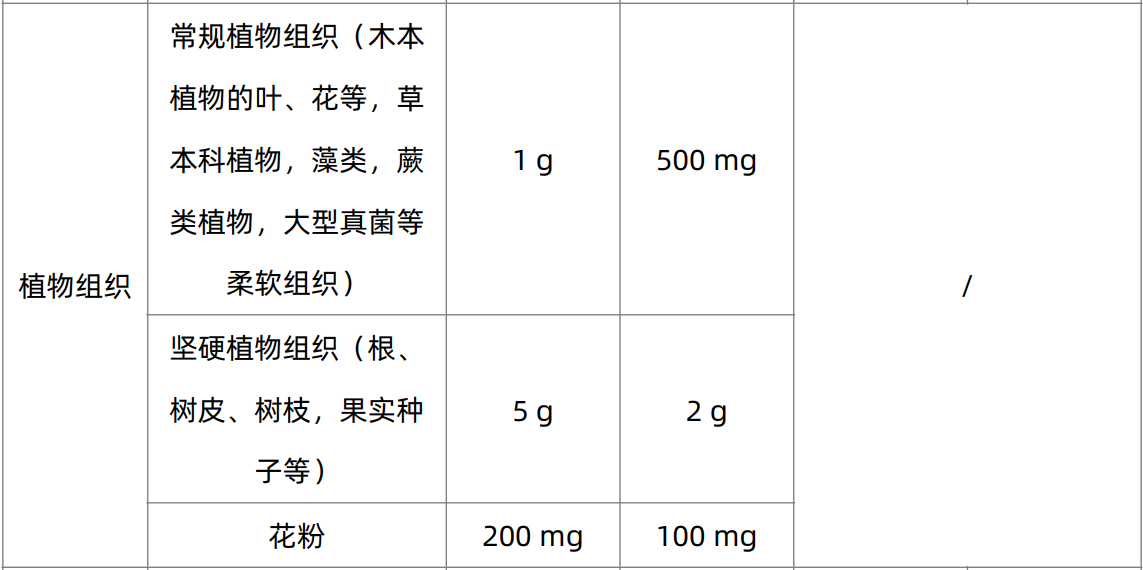
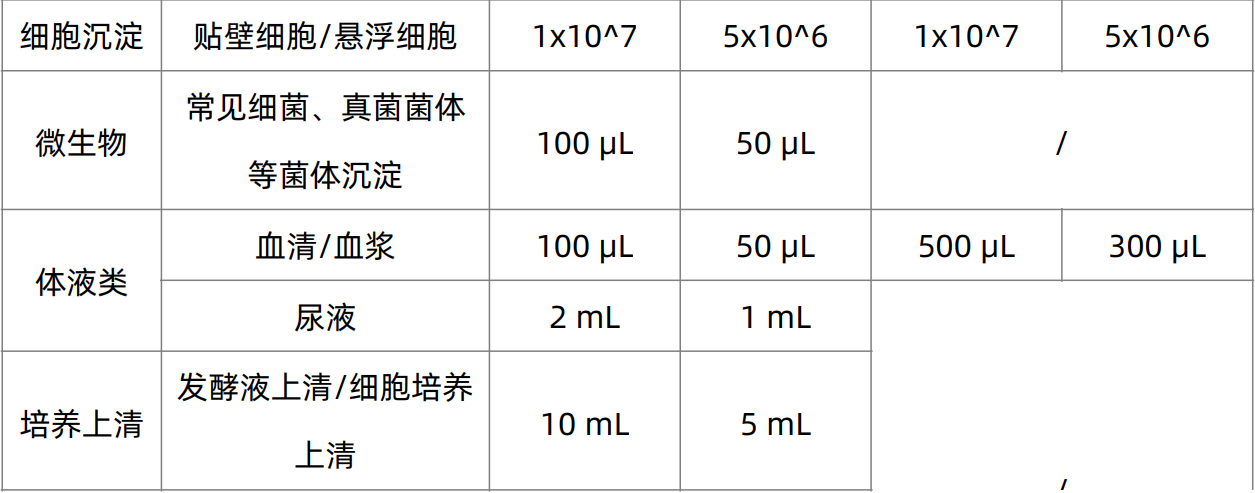

5. Metabolomics
5.1. Untargeted Metabolomics
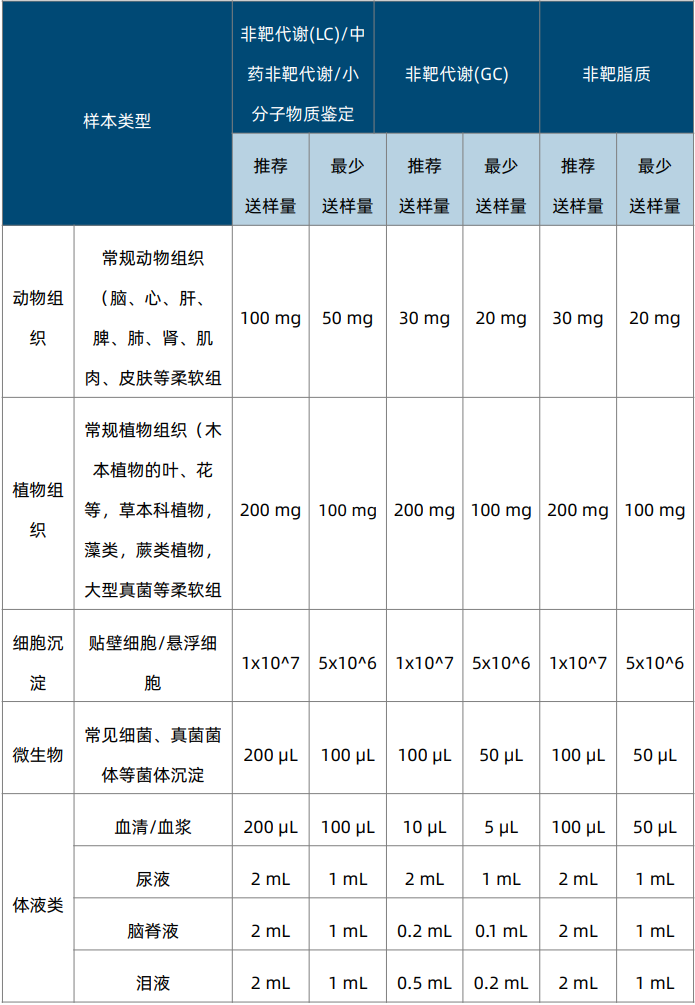

5.2. Targeted Metabolomics
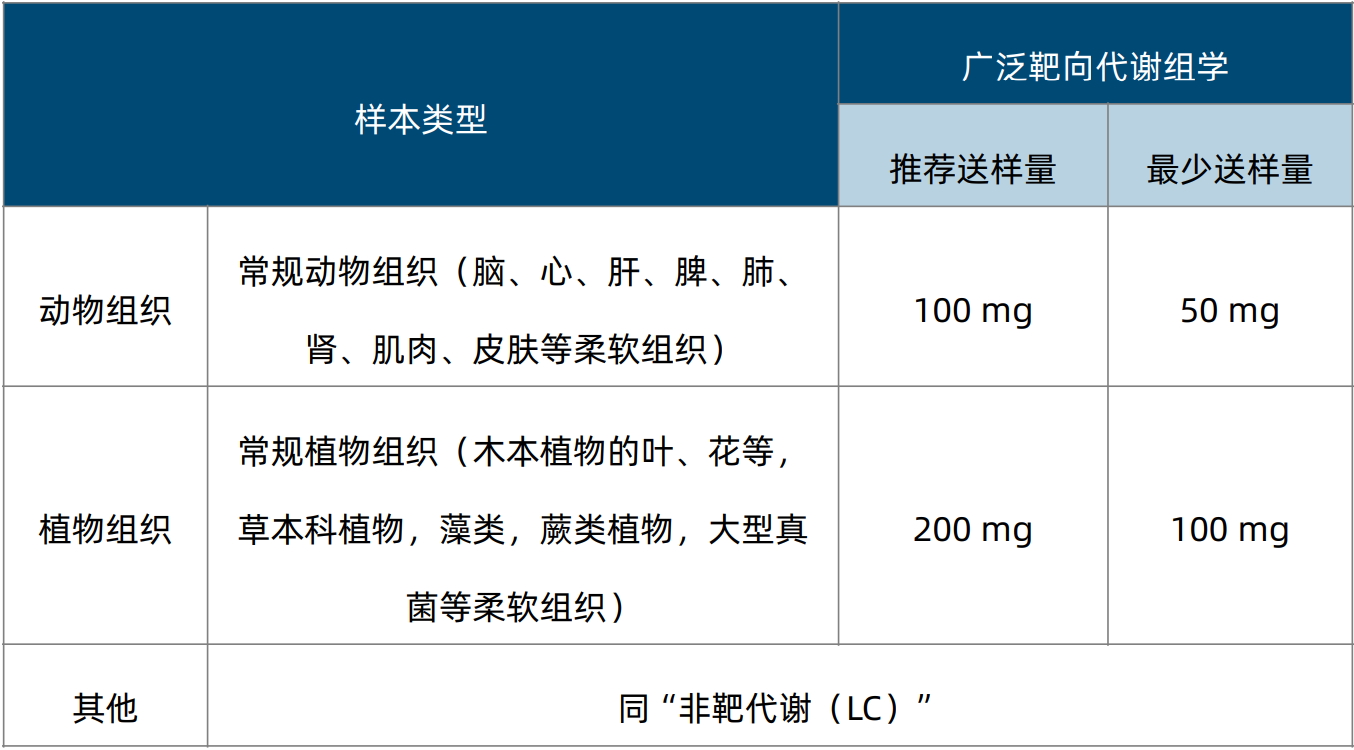
2. Sample Collection Guidelines
1. Sample Collection & Transportation Requirements
(1) Maintain samples at specified temperatures during collection and transportation. For multi-omics studies, it's recommended to aliquot samples during collection to prevent repeated freeze-thaw cycles.
(2) Use ultrapure water for sample collection, and chromatography-grade reagents are recommended when organic solvents are involved.
(3) Use centrifuge tubes made of high-quality materials. Securely wrap samples with sealing film to prevent leakage or contamination during the process (Recommended brands: Eppendorf, Axygen, Corning, etc.).
(4) Since some instruments and software do not recognize Chinese characters and special symbols, sample names should preferably be in English, and underscores can be used if symbols are needed.
(5) Label samples with permanent markers, label multiple areas, and wrap with shock-absorbing materials to prevent damage during cold transport.
(6) Use double-layer foam boxes for sample transportation, and add sufficient dry ice. In summer, use 5kg of dry ice per day; in winter, use 4kg per day. Prepare dry ice according to shipping duration.
2. Animal Tissue Samples
2.1. Conventional Animal Tissues (Brain, Heart, Liver, Spleen, Kidney, Lung, etc.)
(1) Accurately dissect the required tissue and quickly remove fat and connective tissues not needed for study. Divide the tissue into small pieces of 20-50 mg (approximately the size of a soybean).
(2) Rinse the samples quickly in physiological saline or PBS to remove blood and debris.
(3) Use tweezers to transfer the samples to pre-labeled centrifuge tubes, quick-freeze in liquid nitrogen for 10 minutes, and store at -80°C.
(4) Ship with dry ice; avoid repeated freeze-thaw cycles.
Note: For tumor tissues, dissect according to pathological conditions. Adjacent non-tumor tissues should be at least 2 cm away from the lesion.
2.2. Hard Animal Tissues (Bones, Cartilage, etc.)
(1) Wash with PBS and cut cartilage into 1cm by 3cm pieces using a scalpel.3cm pieces.
(2) Transfer to labeled centrifuge tubes, quick-freeze in liquid nitrogen for 10 minutes, and store at -80°C.
(3) Ship with dry ice; avoid repeated freeze-thaw cycles.
2.3. Hard Animal Tissues (Hair)
(1) Wash samples with an appropriate amount of 2% SDS and 50mM sodium phosphate buffer (pH 7.8) to remove contaminants.
(2) Dry the samples, transfer to labeled centrifuge tubes, and store at -80°C.
(3) Ship with dry ice; avoid repeated freeze-thaw cycles.
2.4. Soft-bodied Animals (Schistosomes, Trichinella, etc.)
(1) Collect samples and use pre-cooled PBS to remove host contaminants.
(2) Transfer to labeled centrifuge tubes, quick-freeze in liquid nitrogen for 10 minutes, and store at -80°C.
(3) Ship with dry ice; avoid repeated freeze-thaw cycles.
3. Plant Tissue Samples
3.1. Conventional Plant Tissues (Leaves, Flowers, Fruits, Seeds, Roots, Bark, Ferns, etc.)
(1) Collect specific tissue parts, remove non-target tissues, wash off dust and visible impurities, and dry with lint-free paper.
(2) Wrap in aluminum foil or place in centrifuge tubes, label, quick-freeze in liquid nitrogen for 10 minutes, and store at -80°C.
(3) Ship with dry ice; avoid repeated freeze-thaw cycles.
3.2. Pollen
(1) Collect pollen during the flowering period, check under a dissecting microscope, use dissecting needles to remove anther fragments and other impurities, and transfer to EP tubes.
(2) Check pollen morphology and purity under a light microscope, and store at -80°C.
(3) Ship with dry ice; avoid repeated freeze-thaw cycles.
3.3. Algae
(1) Use appropriate centrifugation force according to different algae types to separate algae while ensuring cell integrity, wash with PBS 2-3 times, quick-freeze in liquid nitrogen for 10 minutes, and store at -80°C.
(2) Ship with dry ice; avoid repeated freeze-thaw cycles.
4. Cell Samples
4.1. Suspension Cells
(1) Centrifuge at 1000g for 10 minutes to collect suspension cells, discard the supernatant.
(2) Wash 2-3 times with pre-cooled PBS, centrifuge, discard supernatant, and collect cell pellet in 1.5mL centrifuge tubes.
(3) Quick-freeze in liquid nitrogen for 10 minutes, and store at -80°C.
(4) Ship with dry ice; avoid repeated freeze-thaw cycles.
4.2. Adherent Cells
(1) Discard the culture medium and invert the culture dish onto absorbent paper to drain excess liquid.
(2) Add pre-cooled PBS at 4°C, gently shake for 1 minute to wash cells, and discard PBS. Repeat these steps twice to remove culture medium.
(3) Place the culture dish on ice, digest with trypsin, and resuspend cells in pre-cooled PBS.
(4) Collect cell suspension in a 15 mL centrifuge tube, centrifuge at 1000g and 4°C for 10 minutes, and discard PBS.
(5) Resuspend cells in 1mL PBS, transfer to a new 1.5mL centrifuge tube, centrifuge, discard PBS, retain cell pellet, quick-freeze in liquid nitrogen for 10 minutes, and store at -80°C.
(6) Ship with dry ice; avoid repeated freeze-thaw cycles.
5. Liquid Samples
5.1. Serum
(1) Collect blood using a vacuum tube (without anticoagulant, recommended red cap) or collect whole blood into a clean centrifuge tube.
(2) Gently invert 8-10 times to mix, and let stand at 4°C for 30 minutes.
(3) Centrifuge at 1000g and 4°C for 10 minutes.
(4) Transfer the light yellow serum from the top layer to a centrifuge tube using a pipette, mix, and spin briefly.
(5) Aliquot 100-200μL per tube as needed for the experiment, quick-freeze in liquid nitrogen for 10 minutes, and store at -80°C.
(6) Ship with dry ice; avoid repeated freeze-thaw cycles.
5.2. Plasma
(1) Collect blood using a vacuum tube (with anticoagulant, recommended purple cap, containing EDTA) or collect whole blood into a tube containing anticoagulant.
(2) Gently invert 8-10 times to mix.
(3) Centrifuge at 1000g and 4°C for 10 minutes.
(4) Transfer the light yellow plasma from the top layer to a centrifuge tube using a pipette, mix, and spin briefly.
(5) Aliquot 100-200μL per tube as needed for the experiment, quick-freeze in liquid nitrogen for 10 minutes, and store at -80°C.
(6) Ship with dry ice; avoid repeated freeze-thaw cycles.
Note: Ensure gentle handling during serum/plasma collection to avoid hemolysis. Samples should be a clear, transparent yellow. If pink or red is observed, hemolytic contamination is present, potentially affecting subsequent results.
5.3. Urine Samples
(1) Collect midstream urine from the first morning void, temporarily store at 4°C (no longer than 8 hours), and avoid bacterial contamination. Control diet before collection.
(2) Centrifuge at 1000g and 4°C for 15 minutes to remove cells or cell debris.
(3) Transfer the supernatant to a new centrifuge tube, aliquot 1mL per tube, quick-freeze in liquid nitrogen for 10 minutes, and store at -80°C.
(4) Ship with dry ice; avoid repeated freeze-thaw cycles.
5.4. Milk, Ascites
(1) Collect milk and ascites samples in centrifuge tubes using clinical collection methods.
(2) Aliquot 1mL per tube as needed for the experiment, quick-freeze in liquid nitrogen for 10 minutes, and store at -80°C.
(3) Ship with dry ice; avoid repeated freeze-thaw cycles.
5.5. Cerebrospinal Fluid, Lymph Fluid, Synovial Fluid, Puncture Fluid
(1) Collect samples in centrifuge tubes using clinical collection methods.
(2) Centrifuge at 1000g~2000g and 4°C for 5 minutes.
(3) Filter the supernatant using a 0.22μm membrane (optional) to collect the filtrate.
(4) Aliquot 100μL per tube as needed for the experiment, quick-freeze in liquid nitrogen for 10 minutes, and store at -80°C.
5.6. Saliva Samples
(1) Fast for at least two hours before sampling, and collect samples between 9-12 a.m.
(2) Centrifuge at 1000g~2000g and 4°C for 5 minutes.
(3) Filter the supernatant using a 0.22μm membrane (optional) to collect the filtrate.
(4) Aliquot 100-200μL per tube as needed for the experiment, quick-freeze in liquid nitrogen for 10 minutes, and store at -80°C.
(5) Ship with dry ice; avoid repeated freeze-thaw cycles.
5.7. Tear Samples
(1) Collect samples using capillary micropipettes, centrifuge at 8000-14000g and 4°C for 5 minutes.
(2) Transfer the supernatant to centrifuge tubes, quick-freeze in liquid nitrogen for 10 minutes, and store at -80°C.
(3) Ship with dry ice; avoid repeated freeze-thaw cycles.
5.8. Cell Culture Medium Supernatant
(1) Refer to cell collection methods to remove original culture medium and collect cells.
(2) Continue culturing cells in serum-free medium for 24-48 hours (depending on cell growth rate to determine supernatant collection time).
(3) Centrifuge at 300g and 4°C for 10 minutes, transfer the supernatant to a 15mL centrifuge tube.
(4) Centrifuge at 3000g and 4°C for 15 minutes to remove excess cell debris.
(5) Transfer the supernatant sample to a new centrifuge tube, aliquot 5-10mL per tube, quick-freeze in liquid nitrogen for 10 minutes, and store at -80°C.
(6) Ship with dry ice; avoid repeated freeze-thaw cycles.
Note: Serum-containing culture media introduces high-abundance proteins in subsequent experiments, significantly reducing identification numbers.
6. Microorganisms
(1) Centrifuge at 5000g and 4°C for 15 minutes, discard supernatant.
(2) Resuspend bacterial pellet with pre-cooled PBS, centrifuge, discard supernatant, repeat 3 times.
(3) Collect bacterial pellet into new centrifuge tubes, aliquot 50-100μL per tube as needed for the experiment, quick-freeze in liquid nitrogen for 10 minutes, and store at -80°C.
(4) Ship with dry ice; avoid repeated freeze-thaw cycles.
7. Feces, Intestinal Contents
7.1. Feces
(1) After defecation, use a sampling spoon to transfer the middle section to labeled centrifuge tubes.
(2) Aliquot samples as needed for the experiment, each tube containing 100~500 mg, quick-freeze in liquid nitrogen for 10 minutes, and store at -80°C.
(3) Ship with dry ice; avoid repeated freeze-thaw cycles.
7.2. Intestinal Contents
(1) Remove the entire intestine, cut the target intestinal region, and longitudinally open the intestine to expose the contents.
(2) Use a sterile sampler to collect intestinal contents into labeled centrifuge tubes (try to collect from deep within the intestine while avoiding intestinal epithelial tissue and blood contaminants).
(3) Aliquot samples as needed for the experiment, each tube containing 100~500 mg, quick-freeze in liquid nitrogen for 10 minutes, and store at -80°C.
(4) Ship with dry ice; avoid repeated freeze-thaw cycles.
8. Environmental Samples
8.1. Soil
(1) Dig soil from 5~20cm below ground, remove visible impurities.
(2) Pass soil through a 2mm mesh sieve, aliquot 5-10g per tube into new centrifuge tubes, quick-freeze in liquid nitrogen for 10 minutes, and store at -80°C.
(3) Ship with dry ice; avoid repeated freeze-thaw cycles.
8.2. Water
(1) Collect the required water sample, let stand for 24 hours, and discard sludge and large particles.
(2) Filter the supernatant through a 0.22μm/0.45μm membrane, retain the membrane, and store frozen at -80°C.
(3) Ship with dry ice; avoid repeated freeze-thaw cycles.
Note:
① 0.45μm filters capture fungi and larger microorganisms, while 0.22μm filters capture bacteria and larger microorganisms. Select the appropriate filter based on research goals.
② Frozen filters become brittle and fragile; it is recommended to proceed with experiments soon after sample collection.
9. Fermentation Residues (Daqu, Fermented Grains, Crops, etc.)
(1) Collect samples, aliquot 2-5g per tube into centrifuge tubes, and store at -80°C.
(2) Ship with dry ice; avoid repeated freeze-thaw cycles.
How to order?





